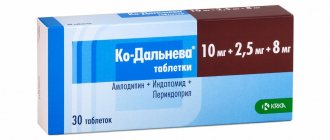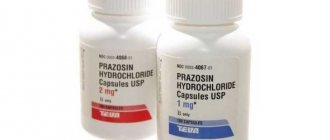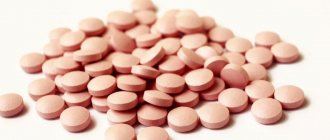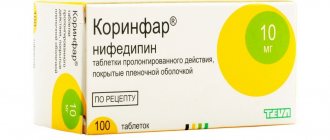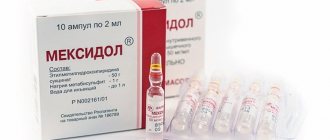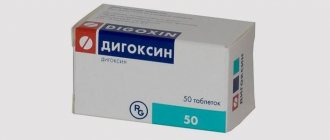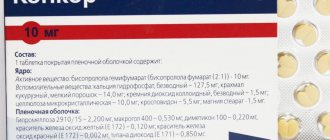Brief information about the drug
The blood pressure drug Lodoz is a combined antihypertensive drug belonging to the pharmacological group of beta-blockers.
Release form
The blood pressure medicine Lodoz is presented on pharmacy counters in tablet form. The tablets may be white, pink or yellow, depending on the dosage of the main active ingredients. The drug is sold in blisters containing 10 capsules. One package can contain 3, 5 or 10 such blisters.
Compound
The main active components of the tablets are hydrochlorothiazide (6.25 mg) and bisoprolol, presented in dosages of 2.5, 5 or 10 mg.
The drug also contains excipients: magnesium stearate, starch, calcium phosphate, crospovidone.
pharmachologic effect
The drug Lodoz is a combined antihypertensive drug with a moderate diuretic effect.
Manufacturer
The manufacturer of the drug Lodoz is a Japanese pharmaceutical company.
Lodoz medicine packaging
Terms and conditions of storage
The maximum permissible shelf life of the drug is 3 years. It is recommended to store the tablets at a temperature of 18-25°C.
Conditions for dispensing from a pharmacy
You can purchase medication in pharmacy chains only by presenting the pharmacist with an appropriate prescription from a medical specialist.
Price
The exact cost of the drug is determined by factors such as the dose of the main active ingredients, the number of blisters with tablets in the package. The average price of Lodoz tablets is about 300 rubles.
Mode of application
Lodoz tablets are taken orally. The daily dose is often prescribed for 1 dose, regardless of food (preferably in the first half of the day). It is not recommended to crush Lodoz tablets before taking them.
It is important to select the dose of the drug Lodoz individually; for this you need to use different forms of release of the drug Lodoz: 10 mg and 6.5 mg or 5 mg + 6.5 mg or 2.5 mg + 6.25 mg (the first number in the combination corresponds to the dose of bisoprolol , the second - a dose of hydrochlorothiazide). The dosage is selected depending on the required dosage of bisoprolol (the dosage of hydrochlorothiazide remains at 6.5 mg per day).
Average dosage of Lodoz medication:
At the beginning of therapy, it is suggested to take 1 tablet of Lodoz 2.5 mg + 6.5 mg per day.
Venza - instructions, composition, dosage, side effects of use
If the effectiveness of the medicine is insufficient, the patient is transferred to taking 1 tablet of Lodoz 5 mg + 6.5 mg per day. If there is a need for a subsequent increase in dosage, the patient is transferred to taking 1 tablet of Lodoz 10 mg + 6.5 mg.
Patients with decreased renal function (with renal clearance greater than 30 ml/min) and hepatobiliary system do not require a change in the dosage of Lodoz.
Duration of treatment and withdrawal of Lodoz tablets:
Lodoz is mainly used for long-term therapy of patients.
The drug is withdrawn slowly (at least 2 weeks). Particular caution should be taken when discontinuing the drug Lodoz in persons with coronary heart disease (in such patients the risk of an angina attack is increased). If necessary, while discontinuing the drug Lodoz, medications are prescribed that are used to prevent angina attacks.
Pharmacodynamics: effect on blood pressure
Lodoz blood pressure tablets lower blood pressure due to the action of the main components of the drug - hydrochlorothiazide and bisoprolol.
Hydrochlorothiazide is characterized by the presence of pronounced hypotensive properties, while acting as a thiazide diuretic. The diuretic effect allows you to stabilize blood pressure, eliminate swelling, congestion and remove excess fluid from the patient’s body.
The combined drug Lodoz combines the action of beta-blockers and diuretics
Bisoprolol is a selective beta-blocker. The therapeutic effect is achieved due to the ability of this substance to reduce the heart rate and reduce the concentration of renin in the blood.
The combination of bisoprolol and hydrochlorothiazide provides a pronounced synergistic effect, allowing you to most effectively and quickly stabilize blood pressure and maintain them at normal levels.
To avoid possible adverse reactions that occur when taking the drugs Hydrochlorothiazide and Bispoprolol simultaneously (headaches, decreased heart rate, asthenic syndrome), the percentage of active ingredients in Lodoz tablets is reduced several times.
Pharmacokinetics of the drug
Hydrochlorothiazide, which is part of the drug, is quickly absorbed into the body through the gastrointestinal tract. Its bioavailability is about 80%. The half-life of this substance from the patient’s body takes about 8 hours. Has the ability to penetrate placental barriers and breast milk during lactation.
Bisoprolol is absorbed by the patient's body by 90%. In the liver it is transformed into inactive metabolites. The bioavailability of bisoprolol is 88%. The half-life is about 11 hours.
The drug Lodoz reduces blood pressure 1–4 hours after taking the tablets. In this case, the hypotensive effect persists for half a day.
LODOZ
Combined antihypertensive drug (selective beta1-blocker + diuretic)
Active ingredients
– hydrochlorothiazide (hydrochlorothiazide) – bisoprolol hemifumarate (bisoprolol)
Release form, composition and packaging
Film-coated tablets
yellow, round, biconvex, with an engraving in the shape of a heart on one side and “2.5” on the other.
| 1 tab. | |
| bisoprolol hemifumarate* | 2.5 mg |
| hydrochlorothiazide | 6.25 mg |
Excipients: magnesium stearate vs – 1 mg, crospovidone – 3 mg, corn starch (fine powder) – 6.75 mg, pregelatinized corn starch – 6.75 mg, microcrystalline cellulose – 37.5 mg, anhydrous calcium hydrogen phosphate (fine powder) – 75 mg.
Shell composition:
Vapadray yellow - 3.5 mg (polysorbate 80 vs - 0.035 mg, dye of iron yellow oxide (E172) - 0.089 mg, macrogol 400 - 0.28 mg, titanium dioxide - 0.891 mg, gipromellose 2910/3 - 1.1025 mg, gypromellose 2910/6 - 1.1025 mg).
10 pieces. – blisters× (3) – cardboard packs×.
Film-coated tablets
pastel pink, round, biconvex, with an engraving in the shape of a heart on one side and “5” on the other.
| 1 tab. | |
| bisoprolol hemifumarate* | 5 mg |
| hydrochlorothiazide | 6.25 mg |
Excipients: anhydrous colloidal silicon dioxide – 0.5 mg, magnesium stearate vs – 2 mg, corn starch (fine powder) – 10 mg, microcrystalline cellulose – 10 mg, anhydrous calcium hydrogen phosphate (fine powder) – 136.25 mg.
Shell composition:
opadry pastel pink – 4.5 mg (polysorbate 80 vs – 0.045 mg, iron dye yellow oxide (E172) – 0.0126 mg, iron dye red oxide (E172) – 0.045 mg, macrogol 400 – 0.36 mg, titanium dioxide – 1.3329 mg, hypromellose 2910/3 – 1.35225 mg, hypromellose 2910/5 – 1.35225 mg).
10 pieces. – blisters× (3) – cardboard packs×.
Film-coated tablets
white, round, biconvex, with an engraving in the shape of a heart on one side and the number “10” on the other.
| 1 tab. | |
| bisoprolol hemifumarate* | 10 mg |
| hydrochlorothiazide | 6.25 mg |
Excipients: anhydrous colloidal silicon dioxide – 0.5 mg, magnesium stearate vs – 2 mg, corn starch (fine powder) – 10 mg, microcrystalline cellulose – 10 mg, anhydrous calcium hydrogen phosphate (fine powder) – 131.25 mg.
Shell composition:
opadry white – 4.5 mg (polysorbate 80 vs – 0.045 mg, macrogol 400 – 0.36 mg, titanium dioxide – 1.40625 mg, hypromellose 2910/3 – 1.34438 mg, hypromellose 2910/5 – 1.34438 mg).
10 pieces. – blisters× (3) – cardboard packs×.
* bisoprolol fumarate (2:1) and bisoprolol hemifumarate are synonymous. × with the “M” symbol applied to protect against falsification.
pharmachologic effect
Lodoz is a combination of a selective beta1-adrenergic receptor blocker - bisoprolol, and a thiazide diuretic - hydrochlorothiazide.
Clinical studies have shown that the hypotensive effect of these two drugs is additive, and have also demonstrated the effectiveness of the smallest dose (2.5 mg + 6.25 mg) in the treatment of mild to moderate hypertension.
Pharmacodynamic effects, including hypokalemia (hydrochlorothiazide) and bradycardia, asthenia and headache (bisoprolol), are dose related. Combination of two medicinal substances in one preparation in doses of one-fourth + half of those used in monotherapy (2.5 mg + 6.
25 mg) reduces the manifestation of such effects.
Bisoprolol
is a highly selective beta1-blocker without adrenomimetic and significant membrane-stabilizing activity. The mechanism of the hypotensive effect of bisoprolol has not been fully established. However, this drug has been shown to significantly reduce plasma renin and reduce heart rate.
Hydrochlorothiazide
is a diuretic from the thiazides group with antihypertensive activity. Its diuretic effect is due to inhibition of the active transport of sodium ions from the renal tubules into the blood, which affects the reabsorption of sodium ions.
Pharmacokinetics
Bisoprolol
Suction
Bisoprolol is almost completely (more than 90%) absorbed from the gastrointestinal tract. The time to reach Cmax in blood plasma ranges from 1 to 4 hours. It has high bioavailability (88%) with a very low “first pass” effect through the liver. Food intake does not affect bioavailability. For doses from 5 to 40 mg, the kinetics are linear.
Distribution
Binding to blood plasma proteins is about 30%, Vd is large (about 3 l/kg).
Metabolism
40% of bisoprolol is metabolized in the liver. Metabolites are inactive.
Removal
T1/2 from blood plasma is 11 hours. Renal and hepatic clearance are approximately comparable. Half of the administered dose is excreted unchanged by the kidneys, as well as metabolites. The total clearance is about 15 l/h.
Hydrochlorothiazide
Suction
The bioavailability of hydrochlorothiazide ranges from 60% to 80%. The time to reach maximum concentration in blood plasma is about 4 hours (from 1.5 to 5 hours).
Distribution
Plasma protein binding 40%.
Removal
Hydrochlorothiazide is not metabolized and is almost completely eliminated unchanged through glomerular filtration and active tubular secretion. T1/2 of hydrochlorothiazide is about 8 hours.
Pharmacokinetics in special clinical situations
In renal and heart failure, the renal clearance of hydrochlorothiazide is reduced and T1/2 increases. In elderly patients, an increase in Cmax in blood plasma is also possible.
Hydrochlorothiazide penetrates the placental barrier and is excreted in breast milk.
Indications
- arterial hypertension of mild and moderate severity.
Contraindications
- hypersensitivity to bisoprolol, hydrochlorothiazide, other thiazides, sulfonamides or other components of the drug;
- severe forms of bronchial asthma;
- acute heart failure or chronic heart failure in the stage of decompensation, requiring inotropic therapy;
- cardiogenic shock;
- SSSU;
- sinoatrial block;
- AV block II and III degrees;
- symptomatic bradycardia (heart rate less than 50 beats/min);
- arterial hypotension (systolic blood pressure less than 100 mm Hg);
- pheochromocytoma (without simultaneous use of alpha-blockers);
- severe forms of peripheral circulatory disorders or severe forms of Raynaud's syndrome;
- metabolic acidosis;
- severe renal dysfunction (CK
Source: https://health.mail.ru/drug/lodoz/
Why is Lodoz prescribed?
Doctors recommend drinking Lodoz for high blood pressure to patients who have indications for the use of this drug, such as arterial hypertension, which occurs in a mild or moderate form of severity.
Tablets are often prescribed to patients with hypertension who are indicated for combination therapy with antihypertensive and diuretic drugs, as well as in cases where treatment with Bisoprolol or Hydrochlorothiazide alone has not brought the desired result.
Lodoz is prescribed to those patients for whom single medications have not brought improvement in the fight against hypertension.
When use is contraindicated
Lodoz for high blood pressure has a fairly wide range of clinical contraindications, some of which are absolute, and some of which are relative.
Absolute contraindications
Doctors categorically prohibit patients who have the following absolute clinical contraindications from taking Lodoz for high blood pressure:
- Severe bronchial asthma;
- Hypotonic disease (stably low blood pressure);
- Raynaud's syndrome;
- Severe bradycardia (with a pulse rate of less than 50 beats per minute);
- Pathologies of the renal apparatus;
- Hypokalemia;
- Individual intolerance and hypersensitivity to the components contained in the tablets;
- Pheochromocytoma;
- Shock state of cardiogenic nature;
- Chronic form of heart failure occurring in the stage of decompensation;
- Slack sinus syndrome;
- Prinzmetal's angina;
- Hypovolemia;
- Liver pathologies;
- Violation of peripheral circulatory processes, occurring in severe form;
- The presence of allergic reactions to sulfonamides;
- Completion of a therapeutic course using Floctafenine, Sultopride, and antiarrhythmic drugs.
The medication is not used to treat children and adolescents under the age of majority.
Chronic heart failure is a contraindication for taking the medicine
Relative contraindications to the use of Lodoz blood pressure tablets include:
- Ischemic disease;
- Thyrotoxicosis;
- Gout;
- Violation of water and electrolyte balance in the body;
- Hypokalemia;
- Psoriasis;
- Hypercalcemia;
- Hyponatremia.
For this category of patients, as well as for the elderly, the drug is prescribed extremely rarely in minimal doses. At the same time, the therapeutic course requires constant monitoring and strict medical supervision.
Lodoz
Precautions associated with the use of bisoprolol
Treatment should not be stopped suddenly, especially in patients with coronary artery disease. It is recommended to reduce the dose gradually over 2 weeks. If necessary, appropriate therapy should be started simultaneously to prevent angina attacks.
If it is necessary to prescribe the drug to patients with bronchial asthma or COPD, treatment should begin with the minimum initial dose. Functional breathing tests are recommended before starting therapy. If bronchospasm develops during therapy, beta-agonists should be prescribed.
In patients with chronic heart failure, the drug should be prescribed with caution and under the supervision of a physician, in minimal doses.
It is necessary to reduce the dose of the drug when the heart rate at rest is <50-55 beats/min and in the presence of clinical symptoms of bradycardia.
Given the negative dromotropic effect of beta-blockers, they should be prescribed with caution to patients with first-degree AV block.
In patients with peripheral circulatory disorders (Raynaud's disease), beta-blockers may cause an exacerbation of the disease.
Patients with pheochromocytoma should not be prescribed Lodoz until they have been treated with alpha-blockers. Blood pressure control is necessary.
In elderly patients, treatment should begin with a low dose of the drug, and careful monitoring of the patient's condition is necessary.
Patients taking Lodoz should be warned about the possibility of hypoglycemia and the need for regular monitoring of blood glucose levels. Bisoprolol may mask the symptoms of hypoglycemia (tachycardia, palpitations and increased sweating).
During therapy with beta-blockers, an exacerbation of psoriasis is possible. Bisoprolol should be prescribed only when necessary.
If there is a history of anaphylactic reactions, regardless of the cause of their occurrence, especially when taking floctafenine, or when carrying out desensitizing therapy, treatment with beta-blockers may exacerbate the occurrence of these reactions and cause the development of resistance to treatment with epinephrine (adrenaline) in normal doses.
Athletes should be informed that Lodoz contains an active substance that may give positive results in doping tests.
Precautions associated with the use of hydrochlorothiazide
Before starting further, monitoring sodium levels in the blood is necessary regularly during therapy. A decrease in sodium levels at the beginning of treatment may be asymptomatic, so regular monitoring is necessary. Particular attention is required in the presence of risk factors, for example, in elderly patients, patients with liver cirrhosis.
Monitoring of blood potassium is necessary in patients at high risk, for example, in elderly patients, in patients receiving thiazide and thiazide-like diuretics, as well as in patients with cirrhosis accompanied by edema, ascites, in patients with coronary artery disease or heart failure, increased QT interval.
Hypokalemia increases the risk of developing arrhythmias and toxicity of cardiac glycosides. The first determination of the level of potassium in the blood should be carried out during the first week of therapy with Lodoz.
Thiazide diuretics may reduce urinary calcium excretion, resulting in mild and temporary hypercalcemia. Transient hypercalcemia may be associated with undiagnosed hyperparathyroidism. Before testing the function of the parathyroid glands, treatment with thiazides must be discontinued.
Monitoring blood glucose levels is necessary in patients with diabetes mellitus, especially in the case of hypokalemia.
Patients with hyperuricemia have an increased risk of developing gout attacks: the dose of the drug must be selected individually.
Thiazide diuretics are effective in patients with normal renal function or slightly reduced renal function (creatinine clearance < 60 ml/min, serum creatinine > 2.5 mg/dl or > 220 µmol/l). In elderly patients, CC can be calculated taking into account the age, body weight and gender of the patient using the Cockroft formula:
For men:
CC (ml/min)= [140-age]× body weight (kg)/0.814 × serum creatinine (µmol/l)
For women:
obtained value × 0.85
Hypovolemia (loss of fluid and sodium) resulting from the use of diuretics at the beginning of therapy leads to a decrease in glomerular filtration rate, which leads to an increase in blood urea and creatinine levels in patients with normal renal function.
Temporary impairment of renal function occurs without consequences in patients with normal renal function. In patients with impaired renal function, existing disorders may worsen.
If the drug is prescribed with another antihypertensive drug, it is recommended to reduce the dose at the beginning of treatment.
Use in pediatrics
Efficacy and safety of the drug in children and adolescents under 18 years of age
have not been established, therefore the use of the drug is contraindicated.
Impact on the ability to drive vehicles and operate machinery
Use with caution when driving a car or operating machinery due to the possibility of dizziness.
Instructions for use and dosage
Instructions for use Lodoza recommends taking the tablets in the morning, before breakfast, without crushing or chewing them, with a glass of water.
The optimal dosage is selected by a medical specialist on a purely individual basis, taking into account factors such as the stage of the pathological process, blood pressure, whether the patient has concomitant diseases and other features of a particular clinical case.
According to the instructions, it is recommended to start the therapeutic course with a dosage of the drug of 6.25/2.5 mg per day. If there is no proper hypotensive effect and the drug is well tolerated, the daily dose of Lodoz can be increased to 6.25/5 mg.
In particularly complex clinical cases, patients are prescribed the maximum allowable dosage of the drug, which is 6.25/10 mg.
Elderly people, in the absence of any relative clinical contraindications, can take the medication in standard doses, without additional correction.
The duration of the therapeutic course is also determined on an individual basis. However, to achieve stable positive results, sufficiently long-term treatment with Lodoz is required.
Do not crush or chew the tablets when taking them
Blister portion
There is no need to take all the tablets at once; it is better to divide them into doses before and after meals.
The dose of the drug is always selected by a specialist individually, based on possible combinations of the drug. The initial and subsequent tablets should be taken only once a day, at approximately the same time.
It is preferable to take Lodoz in the morning during breakfast. Take the tablet with a small amount of water without chewing.
Note! It is impossible to cancel or sharply reduce the dose of the drug on your own, in order to avoid heart rhythm disturbances.
Manifestations of side effects
The drug Lodoz, despite its effectiveness, can cause a number of side effects from various internal organs and systems of the body.
Exchange processes
On the metabolic side, the following undesirable reactions may occur:
- Violations of water and electrolyte balance in the body;
- Metabolic alkalosis;
- Hyponatremia;
- Eating disorder (permanent lack of appetite, or, on the contrary, excessive, uncontrollable feeling of hunger);
- Hyperglycemia;
- Hyperuricemia;
- Hypomagnesemia;
- Hypochloremia.
Skin and subcutaneous tissue structures
The drug Lodoz can provoke the following side effects:
- Skin itching;
- Photodermatitis;
- Allergic rashes like urticaria;
- Hair loss;
- Lupus erythematosus;
- Rush of blood to the skin of the face;
- Skin rashes of a psoriasis-like nature.
In patients suffering from psoriasis, the risk of exacerbation of the disease increases during the therapeutic course.
Taking the medication may worsen psoriasis or cause symptoms.
Heart and blood vessels
When treated with Lodoz tablets, possible manifestations of the following adverse reactions from the cardiovascular system:
- Numbness, decreased sensitivity of the hands and feet;
- Slow heart rate (bradycardia);
- Cold snap, decreased temperature of the upper and lower extremities;
- Worsening of chronic heart failure.
Against the background of an excessive decrease in blood pressure, there is a possibility of developing hypotension, occurring in an orthostatic form.
Other types of side effects
When taking Lodoz medication for high blood pressure, you need to be prepared for the possible occurrence of the following side effects:
- Bronchial spasms;
- Depressive states;
- Sleep disorders;
- Hallucinations;
- Nightmarish dreams;
- Convulsive syndrome;
- Stool disorders (constipation, diarrhea);
- Deterioration of visual function;
- Attacks of dizziness;
- Decreased levels of leukocyte and platelet cellular blood structures;
- Hyperglycemia;
- Muscle weakness;
- Erectile dysfunction in representatives of the stronger sex;
- Glucosuria;
- Painful, uncomfortable sensations localized in the abdominal area;
- Allergic rhinitis.
In rare cases, the drug provokes the development of pancreatitis and agranulocytosis.
The drug may cause sleep disturbances
In what cases can Lodoz not be prescribed?
There are a number of pathologies and conditions for which the drug is not prescribed. These include the following situations:
- If the patient has a history of COPD or severe bronchial asthma.
- Chronic heart failure, which is in a state of decompensation, and if this pathology cannot be treated with medication.
- Cardiogenic shock.
- Increased sensitivity of the body to sulfonamides, including hydrochlorothiazide.
- Sinoatrial block.
- Hypersensitivity to the active substance beta1-blocker bisoprolol.
- If there is a possibility of complications due to any auxiliary component of the drug.
- AV blockade of the first and second degrees, if an artificial pacemaker is not installed.
- If the patient is under 18 years of age.
- Marked bradycardia, in which the heart rate falls below 50 beats per minute.
Clearly expressed bradycardia
- Simultaneous use with certain drugs of similar action. If you want to combine medications, you should definitely consult your doctor.
- Variant angina.
- Liver function is impaired, and the patient's condition is serious.
- If pheochronocytoma is detected, taking beta1-blockers is possible only in combination with alpha-blockers.
- Kidney function is severely impaired, and CK falls below 30.
- Severe pathologies in the peripheral circulation.
- Hypovolemia.
- Arterial hypotension.
- Hypokalemia.
The use of Lodoz in first degree AV block is possible, but with great caution and under constant medical supervision. If there is psoriasis or EBS, mild or moderate heart failure, the drug may be prescribed in minimal doses, followed by correction of therapy.
With thyrotoxicosis, disturbances in water-electrolyte balance, gout and in elderly patients, complications may occur more often, so dose adjustment or an individual Lodoz therapy plan is possible.
Overdose of Lodoza
The use of the drug Lodoz in quantities exceeding the maximum permissible norms leads to the development of an overdose, requiring competent and timely therapy.
Symptoms
An overdose of the blood pressure drug Lodoz is manifested by the following alarming clinical signs:
- Heart failure occurring in acute form;
- Severe bronchial spasms;
- Hypoglycemia;
- A sharp, pronounced decrease in blood pressure, up to the development of a hypotensive crisis;
- Significant reduction in heart rate;
- Atrioventricular block.
When the recommended doses of the medication are chronically exceeded, symptoms such as nausea and vomiting, severe dizziness, and excessive drowsiness appear.
Therapy
The first first aid for an overdose of Lodoz is to lavage the victim’s stomach and take sorbents.
Further treatment is symptomatic and is prescribed by doctors on an individual basis:
- In the presence of bronchial spasms, Aminophylline is prescribed;
- In case of severe hypoglycemia, the patient is given a glucose solution;
- If there is a sharp drop in blood pressure, intravenous administration of vasopressor medications and plasma replacement solutions is required;
- For progressive heart failure, diuretics and vasodilator drugs are used;
- In case of severe bradycardia, intravenous administration of Atropine is practiced, and in especially severe cases, the installation of a pacemaker may be required;
- For atrioventricular block, drugs belonging to the group of beta-adrenergic agonists are prescribed.
It is important not to self-medicate, but at the first symptoms indicating an overdose of Lodoz, seek professional medical help!
Lodoz should be taken strictly as prescribed by your doctor.
Contraindications
Not all patients can use Lodoz to lower high blood pressure. The medication will be prohibited in such pathological conditions as:
- increased susceptibility to the components of the medication;
- bronchial asthma;
- cardiogenic shock;
- acute myocardial dysfunction;
- weak sinus syndrome;
- metabolic acidosis;
- low pressure;
- symptomatic bradycardia;
- problems with the kidneys and liver.
With extreme caution and under the supervision of a doctor, Lodoz should be used by patients who have been diagnosed with a chronic form of heart failure, peripheral circulatory disorders and a decrease in circulating blood volume. It is undesirable to use the drug for diabetes, psoriasis, liver dysfunction and during depression.
During pregnancy, breastfeeding and childhood
Minors cannot be treated with this drug.
Women carrying a child will need to refuse treatment for hypertension with the drug “Lodoz”. The drug in question is also not suitable for nursing mothers, since its active components are excreted in breast milk. Therefore, you will need to stop breastfeeding while taking the pills. People under 18 years of age should not lower their blood pressure with Lodoz.
special instructions
The therapeutic course of Lodoz tablets for patients suffering from pathologies of the respiratory system and bronchial asthma should begin with minimal dosages.
Treatment of patients diagnosed with pheochromocytoma requires careful medical supervision, regular monitoring of blood pressure and simultaneous use of alpha-blockers.
The therapeutic course should be completed smoothly, gradually reducing the daily dose of the drug over 2 weeks.
Pharmacological compatibility
When combining the drug Lodoz with other medications, it is necessary to take into account the drug compatibility of its two main components.
Invalid combinations
It is forbidden to take Lodoz simultaneously with Sultopride, due to the increased risk of developing ventricular arrhythmia.
Combinations not recommended
The combination of Lodoz tablets with calcium channel blockers reduces myocardial contractility.
When combined with lithium drugs, the toxic effect of the latter on the patient’s body increases.
Combination with other antihypertensive medications leads to the development of vasodilation and bradycardia.
Taking tablets against the background of intravenous administration of Verapamil threatens a severe decrease in blood pressure and a hypotensive crisis.
Lodoz may be incompatible with other drugs
Drug combinations requiring caution
The combination of Lodoz with Baclofen, barbiturates, calcium channel blockers, and antidepressants increases the likelihood of developing hypotension.
Combination with antiarrhythmic medications can provoke tachycardia and ventricular arrhythmia.
Use together with Kolestyramine, Colestipol slows down the absorption processes of Lodoz.
Combination with insulin and hypoglycemic agents enhances the hypoglycemic effect of the drug.
Combination with cardiac glycosides increases the risk of bradycardia.
Specific combinations
The combination of Lodoz with Mefloquine leads to a decrease in heart rate. When combined with MAO inhibitors, the risk of developing a hypotensive crisis increases, against the background of a strong decrease in blood pressure.
The use of Lodoz tablets together with glucocorticosteroids, on the contrary, reduces the hypotensive effect of the drug against blood pressure.
Interaction with other drugs
If there is a need for simultaneous use of Lodoz with other antihypertensive drugs, therapy should be started with lower doses than with monotherapy.
Combination therapy with Lodoz with sultopride and floctafenine is prohibited.
It is not recommended to prescribe the drug in combination with lithium, amiodarone, or drugs that may contribute to the development of arrhythmia (including bepridil, erythromycin, astemizole, halofantrine, sparfloxacin, vincamycin, terfenadine and pentamidine).
Lodoz should be used with caution with:
- inhalation agents for general anesthesia and lidocaine;
- baclofen;
- antiarrhythmic drugs (including quinidine, disopyramide, propafenone and hydroquinidine);
- calcium (slow) channel blockers (including diltiazem, bepridil and verapamil);
- insulins and urea medications;
- anticholinesterase drugs;
- iodine-containing contrast agents;
- salicylates (in high doses);
- medications that provoke the development of hypokalemia (including infusion amphotericin, mineralocorticosteroids (with systemic therapy), laxatives, tetracosactide);
- cardiac glycosides, ACE inhibitors;
- potassium-sparing diuretics (including spironolactone, amiloride, triamterene, and canrenone)
- metformin.
The use of antipsychotics or tricyclic antidepressants simultaneously with the drug Lodoz may lead to potentiation of the antihypertensive effect. This combination is not prohibited, but when prescribed, the dose of antihypertensive drugs must be adjusted to avoid an excessive decrease in blood pressure.
Calcium (slow) channel blockers that are dihydropyridine derivatives (including lacidipine, amlopidine, nifedipine, felopidine, nimodipine and nitrendipine) potentiate the hypotensive effect of Lodoz.
There is an increased risk of bradycardia when taking the drug Lodoz simultaneously with mefcholine.
The risk of hypercalcemia increases when taking the drug in combination with calcium medications.
When taking cyclosporine simultaneously with the drug Lodoz, the likelihood of developing hypercreatininemia increases.
The therapeutic result of the drug Lodoz may be reduced with the combined administration of corticosteroids (systemic forms), tetracosactide and non-narcotic analgesics.
Lactasol - instructions, composition, dosage, side effects of use
M-cholinomimetics, when taken in combination with bisoprolol, increase the likelihood of developing atrioventricular conduction disorders and bradycardia.
Local beta-adrenergic blockers (including eye drops) potentiate the effects of Lodoz.
Lodoz tablets may potentiate the hypoglycemic effects of insulin and antidiabetic drugs taken orally, as well as mask the signs of hypoglycemia.
When taking beta-agonists simultaneously with the drug Lodoz, a mutual decrease in effects is observed.
Cases of hemolysis have been described when taking methyldopa in combination with hydrochlorothiazide.
Cholestyramine and colestipol reduce the absorption of hydrochlorothiazide.

